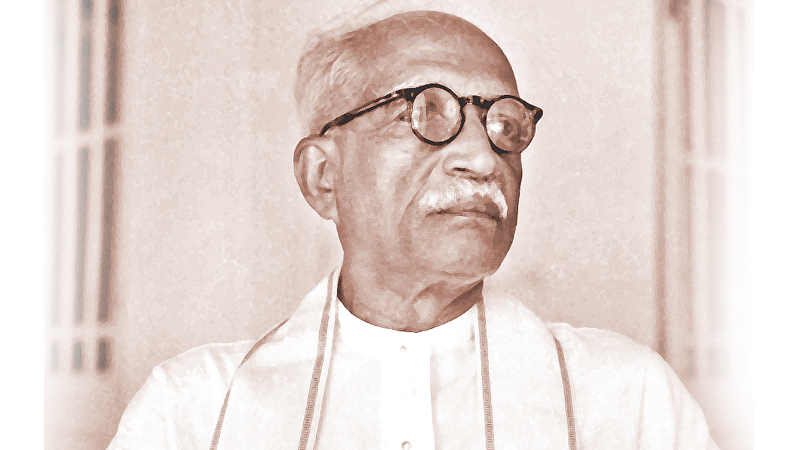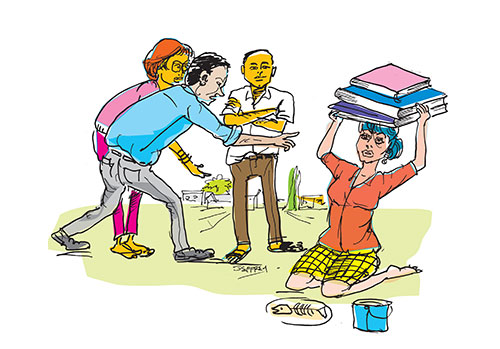by Shamala Kumar
Education is in trouble. Dhammika Perera and other great men with vast repositories of funds and an admirable charitable proclivity may be indeed a great relief to a sector depleted of funds. In fact, from the 1970s, public spending for welfare programmes have plummeted globally, and in Sri Lanka education spending has dropped from 4% of GDP in the 1950-60s to 1.2% in 2022. The era of “trickle-down” economics has justified ending programmes designed to reduce material inequality and brought in its place programmes conducive to capital accumulation, rationalized through arguments that once accumulated, capital would seep into the underbelly of the economy in efficient and effective ways. In doing so, the Thatcherian “dependency” disease would be cured. These policies brought with them heightened wealth disparities and created the likes of Dhammika Perera. It was also the shift towards neoliberalism that ideologically and structurally created a dangerous vacuum into which corporate magnates have stepped in.
The Vacuum – Neoliberal Spaces
Neoliberalism builds on assumptions that human wellbeing and success require institutional structures that favour markets, facilitate individual competition and support the expansion of private enterprise, in the name of efficiency, effectiveness, and innovation. As quoted in Harvey (2005), neoliberal values make market exchange “an ethic in itself, capable of acting as a guide to all human action…” He elaborates “it emphasizes the significance of contractual relations in the marketplace. It holds that the social good will be maximised by maximising… market transactions, and it seeks to bring all human action into the domain of the market.”
With the world turning neoliberal, conceptions of democracy and the role of state and private enterprises have gradually shifted. Democracy after all is messy, inefficient, and the mandates and functions of public institutions have traditionally been inconsistent with free market logic. As markets function to maximize individual returns, people are now construed as mere individuals, each competing for limited resources, for maximum private gain. They are less an integral element of a social system; instead, they are units, each aspiring for self-actualization in a market of goods and services. The state’s role is to remove all barriers as individuals choose and acquire goods and services that can fulfil their desires.
The assumption that such a logic will result in success, however, is flawed even by criteria derived from such thinking. For instance, research indicates that privatized social services have resulted in cost escalations (not efficient) and inferior quality (not effective). Beyond neoliberal metrics of success, however, they have also removed humanity from public institutions, heightened disparities in access and introduced greater precarity into the lives of the poorest segments of society.
Within a neoliberal ideology, public education is assumed to be costly, ineffective, and inefficient, and requiring business interventions to make otherwise. The role of educational institutions, within this logic, is one where consumers (not students) exercise choices in accumulating marketable competencies, through the purchase of knowledge, skills and attitudes from education markets. The crisis is then one of consumers not being able to accrue “quality” competencies. The sterile neoliberal state must ensure that individuals and private enterprises are measurable on a common metric that would allow consumers these choices.
In developing an explanation for why education is in crisis, the problem is narrowly defined as one of inefficiency (and corruption) to be resolved by private sector engagement. Bad teachers and students need to be controlled through managerial systems of monitoring and accountability. If only education were open to markets, it is argued, education would become good. Unspoken is the sense of alienation students experience, shoving “marketable” stuff into their heads in fear of their inadequacy to land jobs in clearly mercilessly classed and gendered markets. Unacknowledged is the violence in considering success simply a function of marketable skill sets and welfare as charitable “handout”. Overlooked is evidence that parental wealth is the best predictor of social mobility and the estimated 30% of our population unable to fulfil necessities, much less pay for education. When framed in the language of markets, the problem is simple. Consider instead, how disquieting framing it as issues of structural inequalities, which free market exacerbate.
No champions from within?
The public, in general, understand how dysfunctional our education system is. One might wonder why those most invested in it, teachers and students, do not push back on these simplistic narratives. Partly, any pushback from within, especially of a collective nature, is labelled as anti-market, backward, inefficient and ineffective. Those speaking out are identified as the bad ones and therefore integral to the problem. Any criticism is further evidence that the system needs fixing. Thus, teachers and students attempting to draw attention to the multiple crises facing education have now been effectively shut up through vilification and repression.
Superman
As the government stews in neoliberal logic, backed by a public groomed for decades into the ideal neoliberal citizen and as public educational institutions flail, with teachers and students effectively mummed into silence, the philanthropist emerges as saviour; a billionaire, savant of private enterprise who will save us from ourselves. Like the Bill and Melinda Gates Foundation, known for its interventions in health and education globally, the Dhammika and Prescilla Perera Foundation is poised to save education in Sri Lanka. The Foundation has over the last few years created and promulgated ‘DP education’, an online platform to supplement school education, a “digital university”, which is a compilation of already available free online university courses or MOOCs (Massive Open Online Courses), and a virtual IT campus. These initiatives will perhaps help students access additional resources, but they are unlikely to solve our crises in education.
The philanthropist himself is a product of the era. The accumulation of capital, facilitated by government policies, have helped create the likes of Bezos and Ambani, of vast wealth; wealth, which a few decades ago, would have been taxed into public coffers. They are men with origin stories of overcoming unfathomable obstacles; superhuman rich people, with megalomaniac aspirations. Their stories align with the individualist narrative of the neoliberal ethic. Any solutions to education by men such as these would likely be ones in which everyone, through sheer will, overcomes their lot in life and achieves the fruits of their labour.
Philanthropists also bring private sector modes of functioning into social programmes – methods that arguably got them their wealth. It likely involved quick, aggressive, and sometimes risky decisions, that disrupt existing structures. Public institutions, theoretically at least, must use bureaucratic systems to ensure a fair process to determine priority, mechanisms and costs. Decision-making is slow and deliberate in contrast to those of the self-described business magnate “disruptors” turned philanthropists. Ramya Kumar (together with Seitz and McCoy – in press) go further, stating that philanthrocapitalism comes with an expectation that welfare investments, as with a business investment, must demonstrate tangible and measurable benefits. Dammika Perera’s vision for Sri Lanka includes revamping education to achieve jobs-related quantified outcomes and ignores complex and less measurable aspirations, such as the nurturing of a citizenry able to foster democracy or an intellectually vibrant society.
The philanthropist is also less subject to public scrutiny. The global reach of the Gates Foundation has resulted in policy interventions across the world (Schwab, 2023). The little independent research available indicates its effectiveness is limited. Resource starved public institutions and nongovernmental agencies that depend on such foundations for funding, fear criticism may dry up precious funds. Schwab, in fact, documents instances where pushback resulted in such effects.
Whereas taxes would have allowed us, some say, into how the funds were spent (at least we have institutions like the PUCSL to investigate the practices of some public institutions), these funds are at the discretion of one or a few individuals. Thus, individuals, merely because they have the funds are given a platform and an inordinate say into public policy. As Wattegama stated in 2022, we must take Dammika Perera’s interventions into education seriously, simply because of his wealth.
As philanthropy becomes a favour source of fundings, reliance on public funds, tied to public policy and democratic process, become a less significant. For higher education, after the financial crisis, this trend is evident. As Prabha Manuratne voiced at a discussion on the subject, education funding has moved from being a political right to a target of charitable giving. Lastly, as Ramya Kumar et al. (in press) state, it also changes the public sentiments towards the philanthropist and the class they belong to, making their wealth palatable to the general public.
As Dammika Perera and others step in to save us and save education, we must view their overtures with caution, asking of our governments why their funds cannot be directed to education through progressive taxation in ways that enhances public scrutiny and public power, rather than diminish them.



